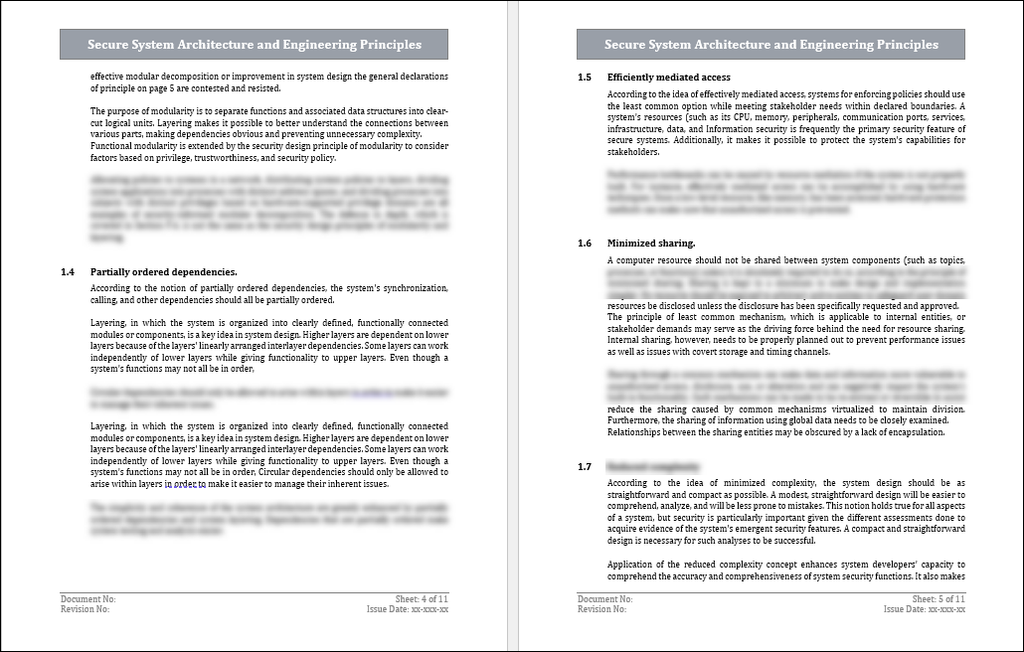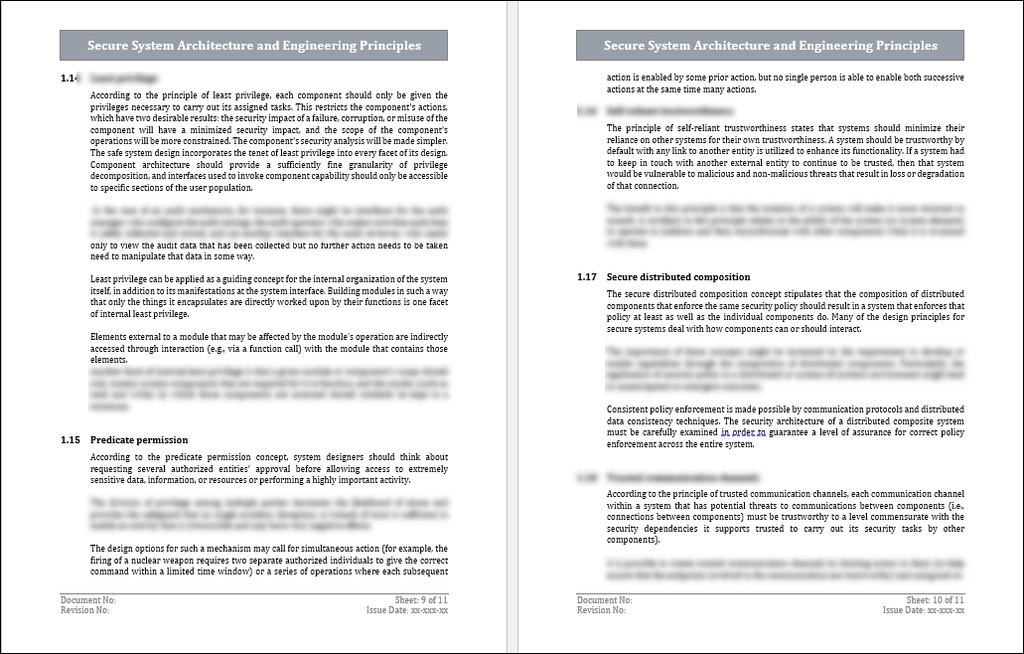ISO 27001 Secure System Architecture and Engineering Principles Template Download
Introduction
In today's interconnected and data-driven world, the security of information systems and applications is paramount. Organizations are exposed to a multitude of cyber threats that can compromise sensitive data, disrupt operations, and damage reputation. To counter these risks, ISO 27001 places significant emphasis on integrating secure system architecture and engineering principles into the fabric of an organization's information security strategy.

The Importance of Secure System Architecture
Secure system architecture holds paramount importance within the ISO 27001 framework as it serves as the bedrock of a comprehensive and effective information security management system (ISMS). ISO 27001 emphasizes the need to design, implement, and maintain secure system architectures to ensure the confidentiality, integrity, and availability of sensitive information.
Here's why secure system architecture is crucial within ISO 27001:
1. Safeguarding Sensitive Information: Secure system architecture ensures that critical information assets are protected from unauthorized access, data breaches, and cyber threats. It establishes a strong barrier against potential attackers seeking to exploit vulnerabilities in the system.
2. Preventing Data Loss and Leaks: A well-designed architecture minimizes the risk of data loss and leaks by incorporating robust access controls, encryption, and data protection mechanisms. This prevents sensitive data from falling into the wrong hands.
3. Mitigating Risks and Vulnerabilities: Secure system architecture identifies and mitigates potential security risks and vulnerabilities during the design phase. By addressing security concerns proactively, organizations can prevent costly security breaches and incidents.
4. Regulatory Compliance: Many industries and regions have strict regulations and compliance requirements for safeguarding data. Secure system architecture ensures that organizations meet these requirements, avoiding legal penalties and reputational damage.
5. Trust and Credibility: Implementing a secure architecture demonstrates an organization's commitment to information security. This enhances trust among customers, partners, and stakeholders, fostering strong relationships and credibility.
6. Reducing Remediation Costs: Addressing security vulnerabilities during the design phase is more cost-effective than trying to fix issues after deployment. Secure system architecture reduces the need for expensive post-incident remediation efforts.
Incorporating secure system architecture into ISO 27001 enhances the organization's ability to effectively manage information security risks, prevent breaches, and maintain a resilient security posture. By prioritizing secure architecture, organizations establish a solid foundation for their information security initiatives, ultimately contributing to their overall success and longevity.

Key Components of Secure System Architecture
Secure system architecture within the ISO 27001 framework encompasses a set of principles, practices, and components that collectively ensure the confidentiality, integrity, and availability of information and systems.
Here are the key components of secure system architecture within ISO 27001:
1. Least Common Mechanism: Avoid shared mechanisms that could create vulnerabilities. Ensure that different components or users do not rely on a single mechanism for security, reducing the potential impact of a breach.
2. Modularity and Layering: Design systems with modular components and layers that can be individually secured. This approach enhances flexibility, maintainability, and the ability to update specific elements without affecting the entire system.
3. Partially Ordered Dependencies: Identify and manage dependencies among system components, ensuring that the security-critical components have minimal dependencies on less secure ones.
4. Efficiently Mediated Access: Implement controlled access mechanisms that efficiently mediate user interactions with system resources. This ensures that authorized users can access resources while preventing unauthorized access.
5. Minimized Sharing: Reduce unnecessary sharing of resources or data between users or components. Limit sharing to only essential cases to prevent unintended access.
6. Reduced Complexity: Strive for simplicity in design and implementation. Complex architectures are more prone to vulnerabilities. Simplifying architecture can enhance security and ease of maintenance.
7. Secure Evolvability: Design architectures that can be updated and evolved without compromising security. This involves maintaining backward compatibility and ensuring that updates don't introduce vulnerabilities.
8. Trusted Components: Utilize components that have been vetted for security. Incorporate trusted third-party libraries, frameworks, and tools to minimize the risk of using vulnerable or compromised components.
9. Hierarchical Trust: Establish trust hierarchies within the architecture. Differentiate between more trusted and less trusted components and ensure that critical components are isolated from less critical ones.
10. Inverse Modification Threshold: Implement a threshold that limits modifications to critical components. This prevents frequent changes to vital parts of the system that might introduce security vulnerabilities.
11. Hierarchical Protection: Implement a protection scheme that reflects the hierarchy of trust within the system. Ensure that higher-trust components have the capability to control and protect lower-trust components.
By integrating these additional points into the design and implementation of secure system architecture within ISO 27001, organizations can further enhance the security, resilience, and effectiveness of their information systems. These principles contribute to the comprehensive approach to information security management advocated by ISO 27001.
Training Employees on Secure System Architecture
Training employees on secure system architecture within the context of ISO 27001 is vital to ensure that everyone in the organization understands the principles, practices, and responsibilities associated with designing and maintaining secure information systems.
Here's a step-by-step guide on how to effectively train employees on secure system architecture:
1. Identify the Audience: Determine the target audience for the training. This may include developers, system administrators, IT managers, and other relevant personnel.
2. Understand ISO 27001 and Secure Architecture: Provide an overview of ISO 27001 and its emphasis on secure system architecture. Explain why secure architecture is crucial for protecting sensitive information and maintaining a strong security posture.
3. Training Content: Cover key concepts such as defense in depth, least privilege, encryption, secure coding practices, access controls, and the importance of secure configuration.
4. Threat Modeling and Risk Assessment: Explain how to perform threat modeling and risk assessments to identify vulnerabilities and threats during the design phase.
5. Access Control Mechanisms: Detail the importance of access controls, authentication, and authorization mechanisms in maintaining secure systems.
6. Encryption and Data Protection: Explain encryption techniques for protecting data at rest and in transit. Emphasize the use of strong encryption algorithms and key management practices.
7. Secure Network Architecture: Discuss the design principles for securing network architecture, including segmentation, firewalls, intrusion detection, and intrusion prevention.
8. Assessment and Feedback: Assess participants' understanding through quizzes, assignments, or discussions. Gather feedback to improve future training sessions.
9. Continuous Learning: Encourage participants to stay updated with the latest security trends and best practices through ongoing learning and industry resources.
By providing thorough training on secure system architecture in line with ISO 27001's principles, organizations can empower their employees to contribute to a secure information environment and reduce the risk of security breaches and incidents. This training cultivates a culture of security awareness and promotes responsible practices throughout the organization.
Conclusion
Secure system architecture and engineering principles play a crucial role in the implementation of ISO 27001, a widely recognized information security management standard. These principles guide organizations in designing, developing, and maintaining secure systems that protect their sensitive information assets and ensure the confidentiality, integrity, and availability of data. A strong emphasis on secure architecture and engineering within ISO 27001 contributes to a comprehensive and systematic approach to managing information security risks.

